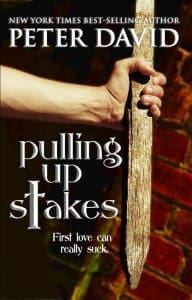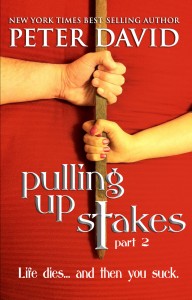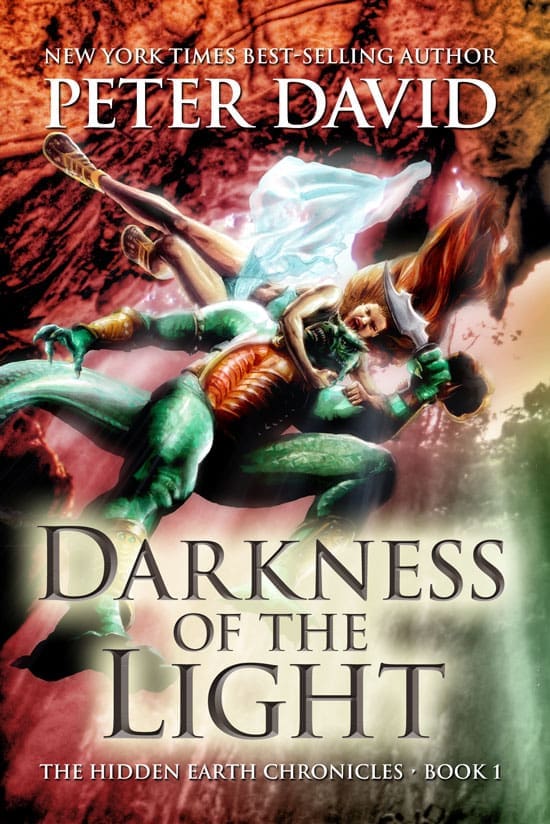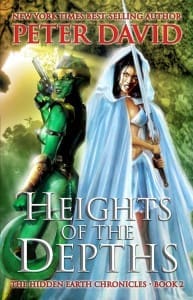 Originally published August 28, 1998 in Comics Buyer’s Guide #1293
Originally published August 28, 1998 in Comics Buyer’s Guide #1293
Before we continue with the thread of last week’s column, I have a bit of business to attend to, so bear with me.
It has come to my attention that there was a guy running around on message boards and DC Comics websites masquerading as me. He has been discussing upcoming events in books of mine (meaning he reads Previews, I suppose) and has also been badmouthing the work of pros such as Grant Morrison. This is not grief I need.
I have enough problems with the opinions I do express, much less now having to deal with opinions I had nothing to do with. I already went on some boards (such as a JLA one) and exposed him as an impostor. But he may be active in other places as well; there are far too many for me to check. So, be warned: if you see message board posts with my name attached, but with an e-mail address other than padguy@aol.com, they are false, and should be reported to me. Thanks.
Okay. Slogging onward:
Picking up from last week, we were discussing truly memorable, shocking, startling, even gut-wrenching moments in “the history of comics” which, according to the staff of Wizard who made these picks, doesn’t really predate 1979. In order to prove that there was life in earlier decades, I’ve been listing memorable moments that happened before then. Picking up where we left off:
7. The death of Richard Sheridan (New Gods #6). Innocent people, civilians, didn’t die in comics. Not ever. I mean, if the Hulk got into a fight with the Abomination and leveled twenty square city blocks, it was always abandoned buildings scheduled for demolition. But Jack Kirby totally squashed that comfort zone with “The Glory Boat,” a devastating tale about a cranky hawk veteran, his pacifist son, and the daughter who was always caught between them in their arguments.
The son, Richard, was held in nothing but contempt by his father who considered his son a coward. A boating accident had stranded the three of them at sea, where despite the desperation of their circumstances, they continued to bicker incessantly. Matters became considerably worse, however, when they wandered into the middle of a battle between the New Gods and the aquatic Apocalypse villains, the Deep Six.
Leaping to his father’s defense, Richard went toe-to-toe with one of the D6, a fight that lasted maybe a panel or two as the villain not only killed the young man, but did so in the most horrific manner of removing his face. Orion showed up a moment later and blasted the bad guy into smithereens, but it was too late to salvage Richard. At the end of the story, with his son dead and gone and his daughter off to safety, the father—his mind shattered—is left adrift to ponder his son who heroically sacrificed himself to save the dad who never had a kind word for him.
8. The petrified bad guy (Adventure Comics #435). Almost any issue of the Spectre under Michael Fleischer’s run was bizarre enough. His work on the title set a new standard for glorious dementia (and I say that with only the greatest respect). There’s any number of shockers to choose from, but probably the most memorable was when the Spectre, the instruments of God’s vengeance and pure annoyance here on earth, disposed of a thug by transforming him into a wood statue and then using a chain saw to carve the guy a new, um, look. The final panel of the sequence had the bad guy sectioned and stacked up like a human Jenga puzzle.
9. The confrontation between the elderly black guy and Green Lantern (Green Lantern/Green Arrow #76). If the creation of Hal Jordan as Green Lantern was one of the defining moments of the Silver Age, this sequence (and retitling of the book) was the redefinition. Green Lantern, who had concentrated his adventures and will-powered ring on matters of mostly cosmic scale, suddenly found himself confronted by a guy who kind of looked like Joe Seneca.
The unnamed elderly black man said that he had heard tell that GL worked for “the blue skins,” and had done considerable things for beings of other assorted hues, but what had he done “for the black skins. Answer me that, Mr. Green Lantern.” A letter writer in a subsequent issue opined that Hal should have replied, “I saved your entire world a half a dozen times, now sod off,” and in real life, he just might have. Maybe even should have.
But the point of the moment was that Hal was becoming so involved with matters of cosmic importance that he had totally lost sight of social difficulties and problems right here on planet earth. Granted, there’s a disturbing side to this logic: It’s exactly the same school of thought that leads short-sighted critics to be opposed to the space program. In this instance, though, it was probably worth it since it lead to a memorable series of stories as GL took a long, hard look at himself, found himself wanting, and wound up going on a road trip with Green Arrow and an incognito Guardian of OA.
You know, they could probably do this comic now as a movie: Make Green Lantern black and cast Danny Glover, have Mel Gibson as Green Arrow, Joe Pesci as the Guardian—you got yourself a film.
10. The cover of Action Comics #1. I know it’s not a story—but it’s a moment nonetheless. Imagine what it must have been like, being a kid and seeing this incredible imagery. A man in a blue and red costume with a cape, lifting a car over his head with no more difficulty than you might lift a baseball, preparing to toss the auto at scattering thieves. Proof that it’s a memorable moment? Not only is it immediately leaping to your mind right now as I describe it, with crystal clarity, but it’s one of the most imitated and “homaged” covers.
It was a comic so memorable that it launched an entire dámņëd genre, for crying out loud: the comic book superhero. (Yes, yes, I know, the Phantom predated him, but even the Ghost Who Walks couldn’t bench-press a Buick.)
Hey, just as an aside, do you realize that the Phantom is the ultimate cross-over hero because you can do stories with him set in any time and place over the past four centuries and have him encounter practically anyone in fiction? Sure, it won’t be Kit Walker, but it’s still the Phantom.
I suggested Phantom meets Tarzan ages ago. How about the Phantom meets Zorro? The Phantom embroiled in the French Revolution, helping out the Scarlet Pimpernel? “The Case of the Skull Headed Ring,” as described by John Watson, M.D. The Phantom head-to-head with Dracula at an earlier time in the vampire’s unlife. Do a whole line of “Phantom Meets” stories. Anyone listening? Lee Falk? The Estates of Edgar Rice Burroughs? The Zorro folks? King Features? Bueller? Anyone? Anyone? But I digress.
11. The Destroyer slicing Thor’s hammer in half (Journey into Mystery #118). Thor’s hammer, the mystic mallet Mjolnir (say that five times fast), was the perfect weapon. Sure, Cap’s shield was cool, but it didn’t hurl thunderbolts or come when you called it. It was the symbol of Thor’s strength and was capable of demolishing buildings or Storm Giants with one swing. So imagine not only the shock of Thor, but the pure amazement of the reader, when Thor came up against the Destroyer, an unstoppable robot created by none other than Odin.
How tough was the Destroyer, you ask? The Destroyer was so formidable that with one ray zap, he sliced the head of the hammer in half. Thor was (appropriately) thunderstruck. And it was a real kick to the head for the reader as well. If the Destroyer, with absolutely no effort whatsoever, was capable of depriving Thor of his single greatest weapon, then Thor was in for the fight of his life.
12. Ben Grimm annihilates Doc Doom (Fantastic Four #40); Reed Richards nearly shishkabobs the Sub-Mariner (Fantastic Four #27). I’m examining these two moments in tandem because they’re really flipsides of the same concept. In FF #40, the depowered Fantastic Four—their abilities dispatched in an earlier encounter with the Frightful Four—found themselves at the nonexistent mercy of Doc Doom who had commandeered the Baxter Building and turned it into a death trap (as supervillains are wont to do.) In a memorable case of the blind leading the powerless, Daredevil helped the FF survive and get to Reed’s lab, wherein Reed Just So Happened to have a device that restored the FF’s powers.
The downside was that Ben Grimm’s power loss had meant that he was back as a human being. Reed’s restoring his powers meant transforming him back into the Thing. As you might surmise, Ben wasn’t ecstatic about it—and chose to take his ire out upon Doom. The infuriated Thing, madder than we’d ever seen him, bursts in on Doom. Doc Doom promptly starts launching everything he has packed in his armor to stop the Thing. The battle is fascinating for two reasons: One, watching the implacable juggernaut that the Thing has become advancing on Doom step by hard-won step. And two, watching Doom’s slowly eroding confidence as the Thing shakes off the best shots the monarch has to offer and keeps on coming. By the time the Thing gets “his mitts” on Von Doom, Doc is actually reduced to screaming at the Thing that he should keep away.
Not surprisingly, the Thing doesn’t oblige—and in one of the most exhilarating defeats in FF history, proceeds not only to crush Doom’s hands, but shred his armor. Only the intervention of Reed Richards stops Ben from tearing Doom’s head from his shoulders. Doom staggers away, looking not like an imperious villain but rather more like a busted tinker toy. No one had lorded it over the FF higher than had Doom, and no one was brought more low in his career.
Contrast and compare one of the FF’s memorable encounters with the Submariner. Enamored of Sue Storm, Namor absconds with her to the ocean floor for the purpose of making her his consort. This move really hacks off Reed Richards, who develops a means of having the FF breathe underwater and launches a rescue attempt. It comes down to a face-to-face between Reed and Namor. Namor had been convinced until that moment that Mr. Fantastic was simply a passionless egghead. He learns differently, and boy, so do we, as Reed comes at him with everything he’s got. Reed employs his pliable body as we’d never seen before.
Nowadays, with so many lethal “heroes” running around, it’s difficult to remember a time when heroes simply didn’t do that kind of thing. But that’s how it was back in the early 1960s, which is why Reed’s actions were all the more stunning. The Submariner, in a rare moment of humbling, find himself purely on the defensive as Reed hammers at him, even going so far as to transform parts of his body into deadly spikes. Only Namor’s speed prevents him from being turned into a pincushion, and the sea king realizes that he is beset by an infuriated “man in love.”
It’s interesting to think of the two FF moments together because they’re so similar—but at opposite ends of the creative scale. In both instances you have two of the FF’s most regal, and arrogantly self-assured, foes. Von Doom is largely intellect, although he packs serious heat; the Submariner depends mostly upon his incomparable strength. In both instances, they go head-to-head with their opposite numbers: The Thing is the incarnation of unintellectual, brute strength; Mr. Fantastic is, for the most part, cerebral and dispassionate. Yet in both battles, the bad guys are humbled as they discover that they have completely underestimated their opponents and are lucky to come out of the encounters in one piece.
13. The death of Xavier (X-Men #42). I know, I know, nowadays death seems routine. And for that matter, it was later revealed that Xavier wasn’t really dead. But at the time, it was nothing short of stunning. The guide, mentor and teacher of the X-Men… died. Perhaps the thing that made it most effective was that it was the loss of a parent figure. Any kid reading it brought that personal resonance to it: The parent is dead. How do we go on? How do we function? How could he leave us behind like this? It worked on so many levels, and was so shocking for the time (as opposed to now, when fans would promptly be starting betting pools to determine how long before Xavier returned) that it has to take its place in comics history.
History—and the forgetting thereof. We’ll broaden our scope next time around to discuss why lack of interest in the true history of the medium is helping to speed its downfall (although anyone who wants to send in their own memorable moments is welcome to do so).
(Peter David, writer of stuff, can be written to at Second Age, Inc., PO Box 239, Bayport, NY 11705).





What a perfect description of what it was like to open Action Comics #1 for the first time. Perfectly captured moment in time 🙂 A great blog!
I’ve always found the Thing turning Doc Doom into a shambling scrapheap to be one of the more memorable Doctor Doom moments. Not sure why given the things he’s been involved with in the Marvel Universe over the years, but that one always stuck out in my mind.
That was one of those moments where I also started wondering if Thing and Hulk didn’t in fact share that whole bit of getting stronger when getting angrier.
“Don’t make me angry, Johnny. You wouldn’t like me when I’m angry.”
“Heck, I don’t much like you now, Blockhead!”
“THAT’S IT, IT’S CLOBBERING TIME!”
That reminds me of a “What if?” story where Reed helped Bruce Banner cure himself of the Hulk. It went wrong and affected the Thing as well, massively upping his strength, but also affecting his mind and filling him with rage. So in the end they wondered if the universe needed a force like the Hulk.